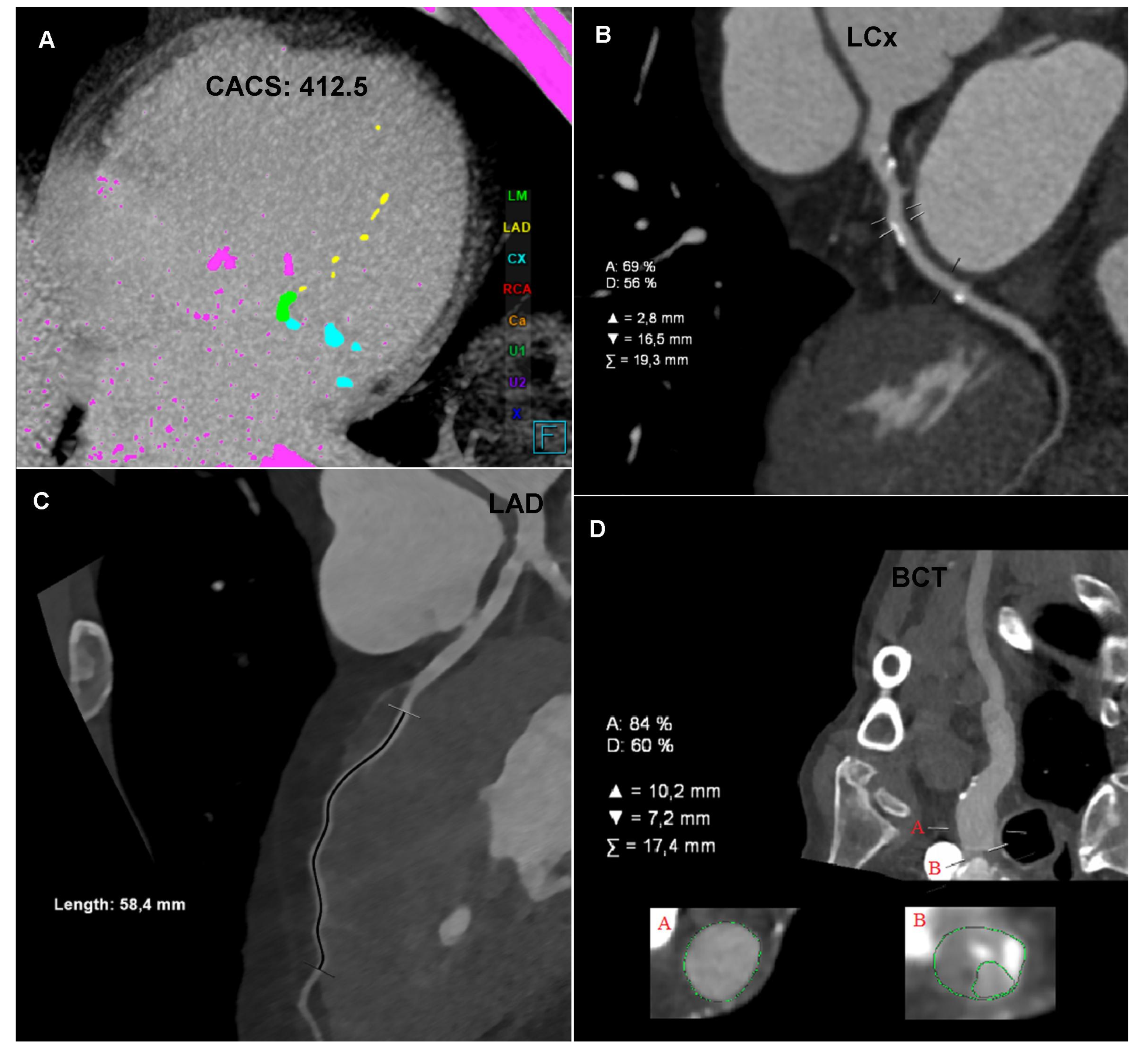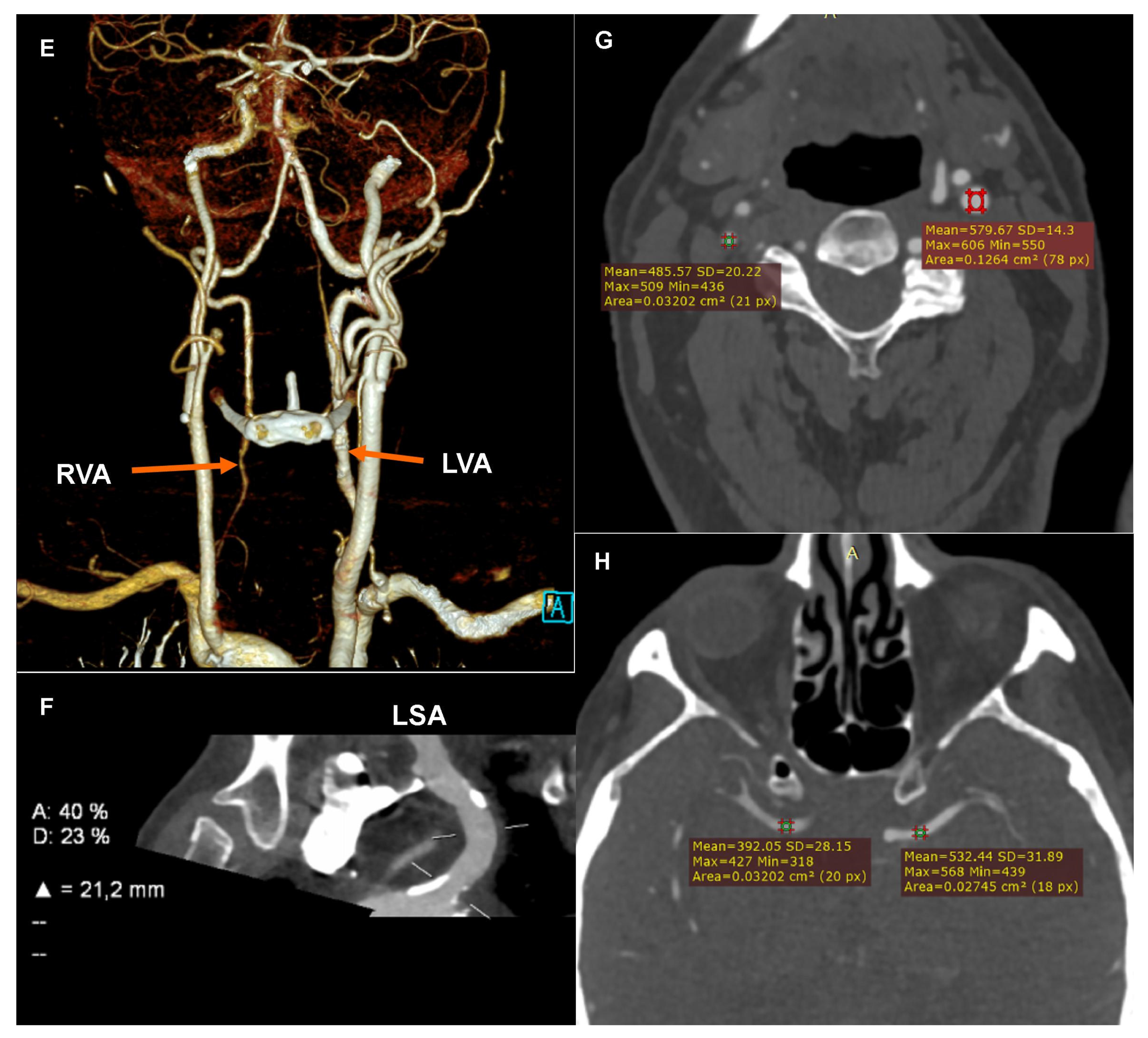Significant Stenosis of the Brachiocephalic Trunk and Moderate Stenosis of the Left Circumflex Artery in Computed Tomography Angiography Images
Abstract
Author Contributions
Funding
Institutional Review Board Statement
Informed Consent Statement
Conflicts of Interest
References
- Cury, R.C.; Abbara, S.; Achenbach, S.; Agatston, A.; Berman, D.S.; Budoff, M.J.; Dill, K.E.; Jacobs, J.E.; Maroules, C.D.; Rubin, G.D. CAD-RADS (TM) Coronary Artery Disease-Reporting and Data System. An expert consensus document of the Society of Cardiovascular Computed Tomography (SCCT), the American College of Radiology (ACR) and the North American Society for Cardiovascular Imaging (NASCI). Endorsed by the American College of Cardiology. J. Cardiovasc. Comput. Tomogr. 2016, 10, 269–281. [Google Scholar] [CrossRef] [PubMed]
- Patel, R.; White, C.J. Brachiocephalic and subclavian stenosis: Current concepts for cardiovascular specialists. Prog. Cardiovasc. Dis. 2021, 65, 44–48. [Google Scholar] [CrossRef] [PubMed]
- Rodriguez, J.D. Brachiocephalic Artery Disease Progression Resulting in Complex Steal Phenomena. J. Diagn. Med. Sonogr. 2016, 32, 173–180. [Google Scholar] [CrossRef]
- Kapa, S.; Adams, J. Subclavian steal and rest pain in a case of brachiocephalic artery occlusion. Int. J. Angiol. Off. Publ. Int. Coll. Angiol. Inc 2008, 17, 166–167. [Google Scholar] [CrossRef] [PubMed][Green Version]
- Paukovits, T.M.; Lukács, L.; Bérczi, V.; Hirschberg, K.; Nemes, B.; Hüttl, K. Percutaneous endovascular treatment of innominate artery lesions: A single-centre experience on 77 lesions. Eur. J. Vasc. Endovasc. Surg. Off. J. Eur. Soc. Vasc. Surg. 2010, 40, 35–43. [Google Scholar] [CrossRef] [PubMed]
- Garabedian, C.P.; Joyce, J.J.; Ross-Ascuitto, N.T.; Ascuitto, R.J. Innominate artery steal syndrome after stage I palliation for hypoplastic left heart syndrome. Pediatric Cardiol. 1998, 19, 458–462. [Google Scholar] [CrossRef] [PubMed]
- Kashiwagi, M.; Kitabata, H.; Tanaka, A.; Arita, Y.; Taruya, A.; Shimamoto, Y.; Yamamoto, Y.; Mori, K.; Nishiguchi, T.; Terada, K. Combination of Lesion Stenosis and Myocardial Supply Area Assessed by Coronary Computed Tomography Angiography for Prediction of Myocardial Ischemia. Int. Heart J. 2019, 60, 1238–1244. [Google Scholar] [CrossRef] [PubMed]
- Razek, A.; Fahmy, D. Coronary artery disease imaging reporting and data system (CAD-RADS): What radiologists need to know? Emerg. Radiol. 2021, 28, 1185–1203. [Google Scholar] [CrossRef] [PubMed]
- Pyxaras, S.A.; Wijns, W.; Reiber, J.; Bax, J.J. Invasive assessment of coronary artery disease. J. Nucl. Cardiol. Off. Publ. Am. Soc. Nucl. Cardiol. 2018, 25, 860–871. [Google Scholar] [CrossRef] [PubMed]
- Foldyna, B.; Szilveszter, B.; Scholtz, J.E.; Banerji, D.; Maurovich-Horvat, P.; Hoffmann, U. CAD-RADS-a new clinical decision support tool for coronary computed tomography angiography. Eur. Radiol. 2018, 28, 1365–1372. [Google Scholar] [CrossRef] [PubMed]
- Villemain, O.; Baranger, J.; Jalal, Z.; Lam, C.; Calais, J.; Pernot, M.; Cifra, B.; Friedberg, M.K.; Mertens, L. Non-invasive imaging techniques to assess myocardial perfusion. Expert Rev. Med. Devices 2020, 17, 1133–1144. [Google Scholar] [CrossRef] [PubMed]


Publisher’s Note: MDPI stays neutral with regard to jurisdictional claims in published maps and institutional affiliations. |
© 2022 by the authors. Licensee MDPI, Basel, Switzerland. This article is an open access article distributed under the terms and conditions of the Creative Commons Attribution (CC BY) license (https://creativecommons.org/licenses/by/4.0/).
Share and Cite
Gać, P.; Poręba, R. Significant Stenosis of the Brachiocephalic Trunk and Moderate Stenosis of the Left Circumflex Artery in Computed Tomography Angiography Images. Diagnostics 2022, 12, 200. https://doi.org/10.3390/diagnostics12010200
Gać P, Poręba R. Significant Stenosis of the Brachiocephalic Trunk and Moderate Stenosis of the Left Circumflex Artery in Computed Tomography Angiography Images. Diagnostics. 2022; 12(1):200. https://doi.org/10.3390/diagnostics12010200
Chicago/Turabian StyleGać, Paweł, and Rafał Poręba. 2022. "Significant Stenosis of the Brachiocephalic Trunk and Moderate Stenosis of the Left Circumflex Artery in Computed Tomography Angiography Images" Diagnostics 12, no. 1: 200. https://doi.org/10.3390/diagnostics12010200
APA StyleGać, P., & Poręba, R. (2022). Significant Stenosis of the Brachiocephalic Trunk and Moderate Stenosis of the Left Circumflex Artery in Computed Tomography Angiography Images. Diagnostics, 12(1), 200. https://doi.org/10.3390/diagnostics12010200






